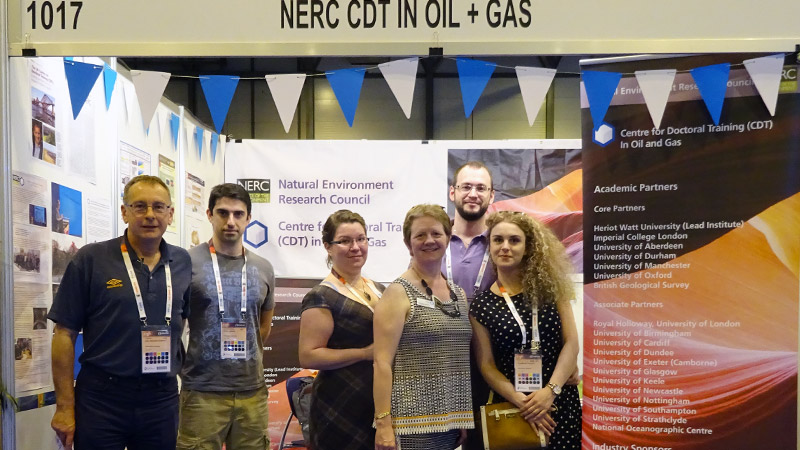
The NERC CDT took its message of collaborative research and training between academia, industry and regulators to its first international meeting by exhibiting at the 77th Annual Conference of the European Association of Geoscientists and Engineers (EAGE) in Madrid from 1st – 4th June 2015.
The conference was entitled ‘Earth Science for Energy and Environment’ and offered a wide range of presentations from industry and academia, including a very varied student programme, at which several HWU staff and PhD students presented their current research results.
The booth was manned by the CDT Manager, Lorna Morrow and Training Academy Officer, Anna Clark throughout the meeting and proved to be a popular addition to the conference exhibition.
The current EAGE President, Prof. Philip Ringrose, was one of the contributors to the first residential course run as part of the Training Academy element of the CDT model at Heriot-Watt in November 2014 and he was pleased to support the CDT by visiting the booth and promoting the CDT at the conference.
Prof. Ringrose works for Statoil, one of the CDT’s nine industry partners who sponsor the 20 weeks’ of training provision that the NERC CDT students benefit from during the first three years of their 4-year studentships. Prof. Ringrose was delighted to meet Rachael Hunter and Ross Grant, two of the first cohort of CDT PhD students and Stavros Vrachliotis, one of the new 2015 entrants, at the stand and to hear of their experiences of the Training Academy courses they have already attended, both at Heriot-Watt and at the University of Manchester.
Despite the current dip in the oil price and resultant economies being implemented by companies, the conference and exhibition attracted over 6,000 delegates and the CDT representatives introduced this pioneering model of doctoral research and training to many potential student applicants to the 2015 and 2016 cohorts. The final motivational speech in the Student Programme of the conference was given by Mr. Paul Gérard of Repsol, entitled ‘The Role of Students in Collaboration between Academia and Industry’, not only demonstrating EAGE’s awareness of the importance of this theme to the current recruitment environment in this field, but also providing the CDT with an excellent opportunity to showcase the advantages of its own collaborative approach.
There were also many opportunities to highlight the benefits of this model to possible industry sponsors from Europe, the US and China in particular. The CDT representatives demonstrated the galvanising effect on the oil & gas community in the UK of its partnership of 17 universities, 2 research organisations and major industry sponsors which provides a forum for students and professionals from a variety of academic disciplines and operational backgrounds to exchange knowledge and experience, acquire new skills and promote informed debate on the energy challenges facing the world in the 21st century.
Following the conference, the CDT Academic Lead, Prof. John Underhill, Anna Clark, and a number of PhD students undertook a weekend fact-finding field trip to the Basque-Cantabrian Basin in Northern Spain accompanied by two colleagues from the Spanish oil company, CEPSA. The Basque-Cantabrian Basin encapsulates a variety of tectonic settings, lithologies and geologically significant outcrops and located within it is the Ayoluengo field, Spain’s only onshore oil-producing field and the Hontomin Discovery, which is a test case for Carbon Storage. The area is thus an ideal training ground, providing students with an excellent demonstration of a working petroleum system, from source rock to reservoirs to producing wells, as well as highlighting the local and regional geological complexity through numerous world class outcrops. It also provides opportunities to address the environmental impact and remediation techniques required to manage these kinds of operation in a rural but populated area, thus addressing several of the key themes of the CDT’s research profile in the one trip. The aim now is to evaluate the key learnings from the field trip so that it may be added to the CDT Training Academy portfolio of courses for the benefit of more students.
